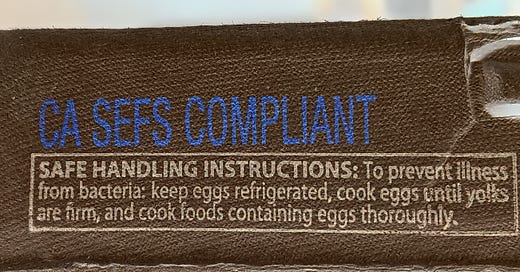In 2019 my home state of Washington, USA passed a law that states, that all retailers must include proof that all eggs and egg products provided in intrastate commerce follow guidelines for cage-free housing.
The law passed in 2019 required these changes to be in effect by January 2024, effectively doubling the price of eggs overnight.
As an egg consumer, this threw me for a loop when I ventured out for my first grocery shopping trip of the year. At first, I didn’t even notice that all the eggs in the store were labeled “cage-free”, I just saw a significant and unwelcomed hike in price.
The dozen eggs that had been $2.99 were now $4.99 at the cheapest!
When I saw this I thought ok, so these eggs must be of higher quality, as I had purchased farm fresh eggs and other, more expensive eggs in the past when it was feasible and the quality was a vast improvement over the standard commercial eggs, but that was not the case.
In my opinion, high-quality eggs have a thicker white and the yolk is a vibrant dark yellow to almost orange color with a rich flavor. Low-quality eggs would be the opposite, watery whites with a pale yellow yolk and a very mild or bland flavor.
The new cage-free eggs yielded zero increase in quality for the price, they appear to be the same commercial eggs that were sold at the lower price just a month prior.
Why has the quality stayed the same but the price went up? Did the egg producers start feeding the chickens a higher quality feed? Judging by the appearance it would seem like they didn’t.
Since the egg producers now have to provide proof of the cage-free conditions, and I’m sure there’s an added cost to that, they did what any other business would do and passed that cost along to the customer.
So by the time the eggs hit the shelves, they’re twice as much as they used to be for the same product.
What is a cage-free egg?
According to the USDA, eggs for sale labeled as cage-free must be produced by hens housed in a building, room, or enclosed area that allows for unlimited access to food, water, and provides the freedom to roam within the area during the laying cycle.
The law aims to improve the welfare of millions of hens and aligns with similar movements across other states. It has prompted producers to invest in and transition to cage-free systems to meet the regulatory standards.
I am all for animal welfare and believe that factory farming and overcrowded chicken houses are disgusting, but doubling the price of eggs overnight took some by surprise.
Eggs are an extremely versatile culinary tool and are used for more than just fried eggs and omelets, restaurants go through a ton of eggs even if eggs aren’t on the menu.
If you had anything battered and fried most of the time eggs were involved. If you buy virtually anything from a bakery, it probably has eggs as an ingredient.
This means the price of those goods just went up, and if they didn’t, the restaurant and its employees have to eat the cost, and with restaurant profit margins being on average about 3-5% I guarantee you that’s not going to happen.
Restaurants that do feature eggs on their menus like diners and breakfast restaurants are getting hit even harder as they already go through hundreds of eggs per day.
When prices of goods and services go up, restaurants, especially small restaurants are forced to raise their prices on most menu items if not all, or they have to cut labor costs just to offset the price of one ingredient.
Large food suppliers like Sysco and U.S. Foods have been somewhat able to keep their prices down to about $30-$35 per case due to their purchasing power, but that’s the wholesale market, the retail market is another 30-50% jump in price.
If a restaurant isn’t big enough to necessitate a larger Sysco order they usually purchase products from a smaller wholesaler like The U.S. Foods Chef’s Store (formerly Cash N Carry Smart Foodservice) with the price of a case of eggs (15 DZ) coming in between $50-$60, which were between $25-$30 before the cage-free law went into effect.
Eggs have always been a fairly cheap source of protein for people and families on a budget as eggs are a staple food.
A couple of stores in my local area have begun to sell Grade B eggs alongside Grade AA or A. Don’t be afraid of the Grade B, which is in my opinion, a superior product at half the price of the cage-free.
They resemble eggs that a farmstand might sell as they’re not all the same color but the taste and texture are that of a quality egg.
As the cost of food continues to rise across the board, we all will have to continue to figure out ways to source more affordable ingredients, and ideally be as self-sufficient as we can.








It's really tough to balance affordability with animal welfare, which I'm all for. I think it has to be done gradually, or else the knee-jerk reaction is just too much. You have to give folks a little time to adjust to the changes gradually.